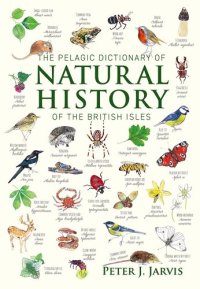
Ebook: The Pelagic Dictionary of Natural History of the British Isles: Descriptions of all Species with a Common Name
Author: Peter Jarvis
- Genre: Biology
- Year: 2019
- Publisher: Pelagic Publishing
- City: Exeter
- Language: English
- epub
A unique collection of concise but detailed information on 10,000 animals, plants, fungi and algae of the British Isles. Every species with an English common name is included.
The compendium is in two parts. The first, smaller part, looks at various terms that people interested in natural history may come across. The second provides information on individual species or species groups, with entries on those with English (common) names, as well as selected families, orders, classes, etc. In the case of marine organisms, entries are given for intertidal and subtidal invertebrate species, and generally speaking for fish species that might be observed inshore. Indication is often given on distribution as well as whether a species is common, scarce or something in between. For some species a note is made of population size and trends. Comments are made where appropriate on etymology, both of the English name and the binomial.
All British vertebrates are included mammals (101 species), birds (590), herpetofauna (30), freshwater and estuarine fishes (56), together with some coastal fishes. There are around 2,800 entries for invertebrates some two-thirds being for insects. Most invertebrates do not have common names, so for instance there are entries for only 84 of the over 250 species of bee found in the British Isles. All vascular plants are covered (2,950 species), as are all mosses (around 760), and liverworts and hornworts (288). About 1,000 of the 1,700 known lichen species are included, 1,410 of the 12,000 or so fungi, and some 50 macroalgae (i.e. seaweeds).
No other natural history dictionary or cognate publication relating to the British Isles is as comprehensive in taxonomic cover.
The compendium is in two parts. The first, smaller part, looks at various terms that people interested in natural history may come across. The second provides information on individual species or species groups, with entries on those with English (common) names, as well as selected families, orders, classes, etc. In the case of marine organisms, entries are given for intertidal and subtidal invertebrate species, and generally speaking for fish species that might be observed inshore. Indication is often given on distribution as well as whether a species is common, scarce or something in between. For some species a note is made of population size and trends. Comments are made where appropriate on etymology, both of the English name and the binomial.
All British vertebrates are included mammals (101 species), birds (590), herpetofauna (30), freshwater and estuarine fishes (56), together with some coastal fishes. There are around 2,800 entries for invertebrates some two-thirds being for insects. Most invertebrates do not have common names, so for instance there are entries for only 84 of the over 250 species of bee found in the British Isles. All vascular plants are covered (2,950 species), as are all mosses (around 760), and liverworts and hornworts (288). About 1,000 of the 1,700 known lichen species are included, 1,410 of the 12,000 or so fungi, and some 50 macroalgae (i.e. seaweeds).
No other natural history dictionary or cognate publication relating to the British Isles is as comprehensive in taxonomic cover.
Download the book The Pelagic Dictionary of Natural History of the British Isles: Descriptions of all Species with a Common Name for free or read online
Continue reading on any device:

Last viewed books
Related books
{related-news}
Comments (0)